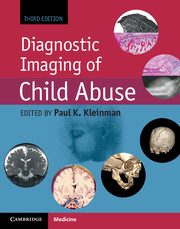Book contents
- Frontmatter
- Dedication
- Contents
- List of Contributors
- Editor’s note on the Foreword to the third edition
- Foreword to the third edition
- Foreword to the second edition
- Foreword to the first edition
- Preface
- Acknowledgments
- List of acronyms
- Introduction
- Section I Skeletal trauma
- Section II Abusive head and spinal trauma
- Chapter 16 Abusive head trauma: clinical, biomechanical, and imaging considerations
- Chapter 17 Abusive head trauma: scalp, subscalp, and cranium
- Chapter 18 Abusive head trauma: extra-axial hemorrhage and nonhemic collections
- Chapter 19 Abusive head trauma: parenchymal injury
- Chapter 20 Abusive head trauma: intracranial imaging strategies
- Chapter 21 Abusive craniocervical junction and spinal trauma
- Section III Visceral trauma and miscellaneous abuse and neglect
- Section IV Diagnostic imaging of abuse in societal context
- Section V Technical considerations and dosimetry
- Index
- References
Chapter 19 - Abusive head trauma: parenchymal injury
from Section II - Abusive head and spinal trauma
Published online by Cambridge University Press: 05 September 2015
- Frontmatter
- Dedication
- Contents
- List of Contributors
- Editor’s note on the Foreword to the third edition
- Foreword to the third edition
- Foreword to the second edition
- Foreword to the first edition
- Preface
- Acknowledgments
- List of acronyms
- Introduction
- Section I Skeletal trauma
- Section II Abusive head and spinal trauma
- Chapter 16 Abusive head trauma: clinical, biomechanical, and imaging considerations
- Chapter 17 Abusive head trauma: scalp, subscalp, and cranium
- Chapter 18 Abusive head trauma: extra-axial hemorrhage and nonhemic collections
- Chapter 19 Abusive head trauma: parenchymal injury
- Chapter 20 Abusive head trauma: intracranial imaging strategies
- Chapter 21 Abusive craniocervical junction and spinal trauma
- Section III Visceral trauma and miscellaneous abuse and neglect
- Section IV Diagnostic imaging of abuse in societal context
- Section V Technical considerations and dosimetry
- Index
- References
Summary
Overview
The most feared consequence of child abuse is brain injury. Abusive head trauma (AHT) can result in significant brain injuries that can cause death or lifelong handicap of a child, with the full consequence not truly evident until school age or later. AHT is the most common cause of traumatic death for infants with as many as one in four victims of AHT/shaken baby syndrome (SBS) dying (1). Almost all suffer serious health consequences such as sensory impairments as well as cognitive, learning, and behavioral disabilities (2).
These parenchymal brain injuries can be quite subtle initially, but the appropriate history or the presence of intracranial hemorrhage or extra-axial collections should trigger a search for subtle changes that indicate evolving brain injury. Although some parenchymal brain injuries observed in AHT are similar to those observed in accidental trauma, there are injury patterns that are more common in documented cases of abuse. The uniqueness of these injury patterns is likely due to a combination of specific mechanical forces and the vulnerability of the immature brain, particularly in infancy. Infants are more susceptible to direct mechanical brain injury from abusive shaking owing to poor neck control, larger head size, and softer brain owing to incomplete myelination. Also with shaking, indirect injuries from associated cardiac and/or respiratory compromise may occur. To further complicate matters, physiologic cascades cause the imaging appearance of abusive brain injury to evolve over time. To better understand the evolution of brain injury, we begin with an overview on cell death processes in the immature brain. Next we divide parenchymal injuries into those caused by direct mechanical forces (primary injuries) and those associated with, but not directly due to mechanical forces (secondary injuries). Also included is a discussion on mechanisms of injury for different imaging patterns of brain injury, recognizing that in some cases mechanisms are unproven or controversial. Finally, we remind the reader that it is common for severe brain injury to be present in the absence of external evidence of injury (3, 4). Therefore, brain imaging should be performed if there is a high clinical suspicion or if neurologic signs and symptoms are present, even if there are no overt signs of abuse. The recommended neuroimaging protocol is provided in Chapter 20.
- Type
- Chapter
- Information
- Diagnostic Imaging of Child Abuse , pp. 453 - 486Publisher: Cambridge University PressPrint publication year: 2015
References
- 3
- Cited by



